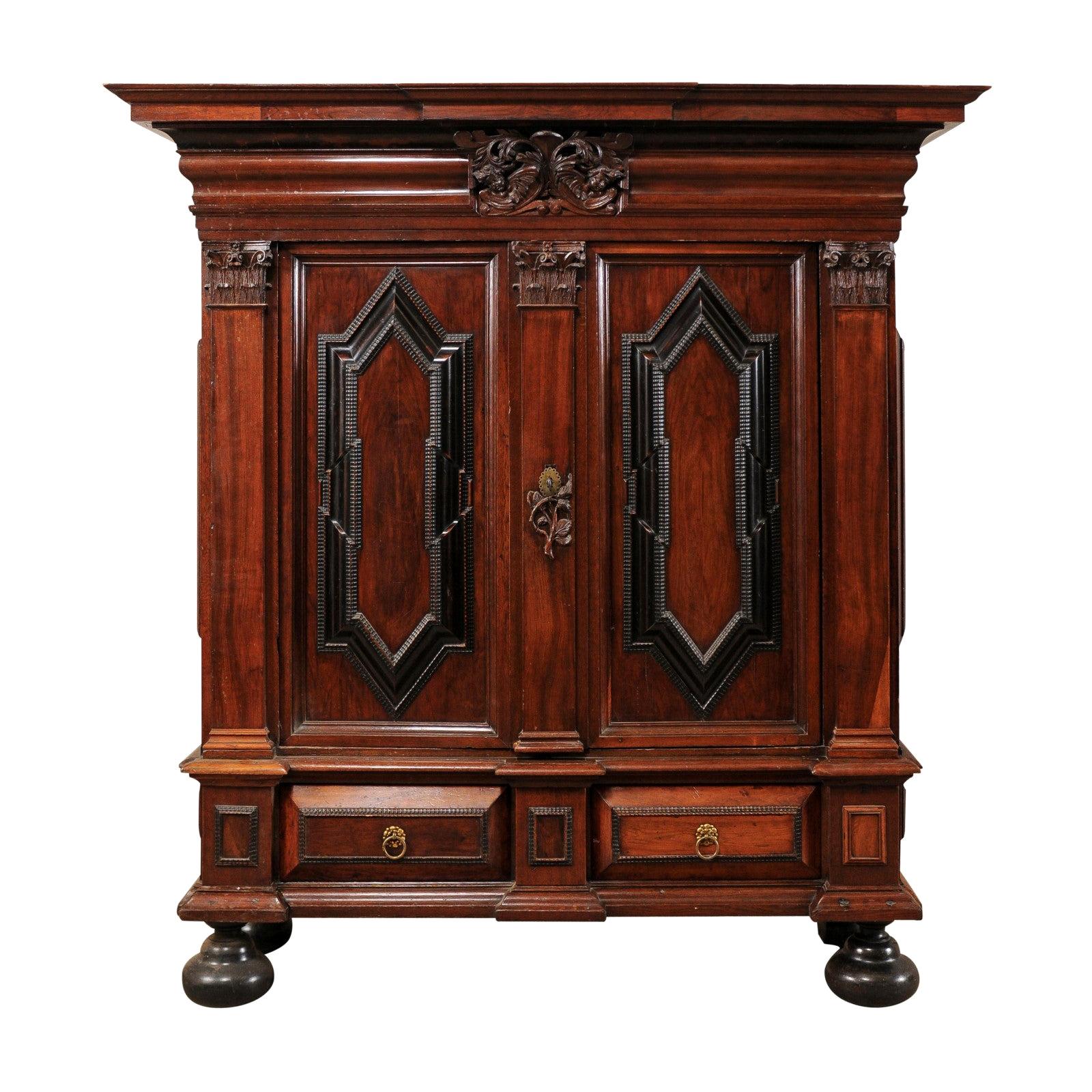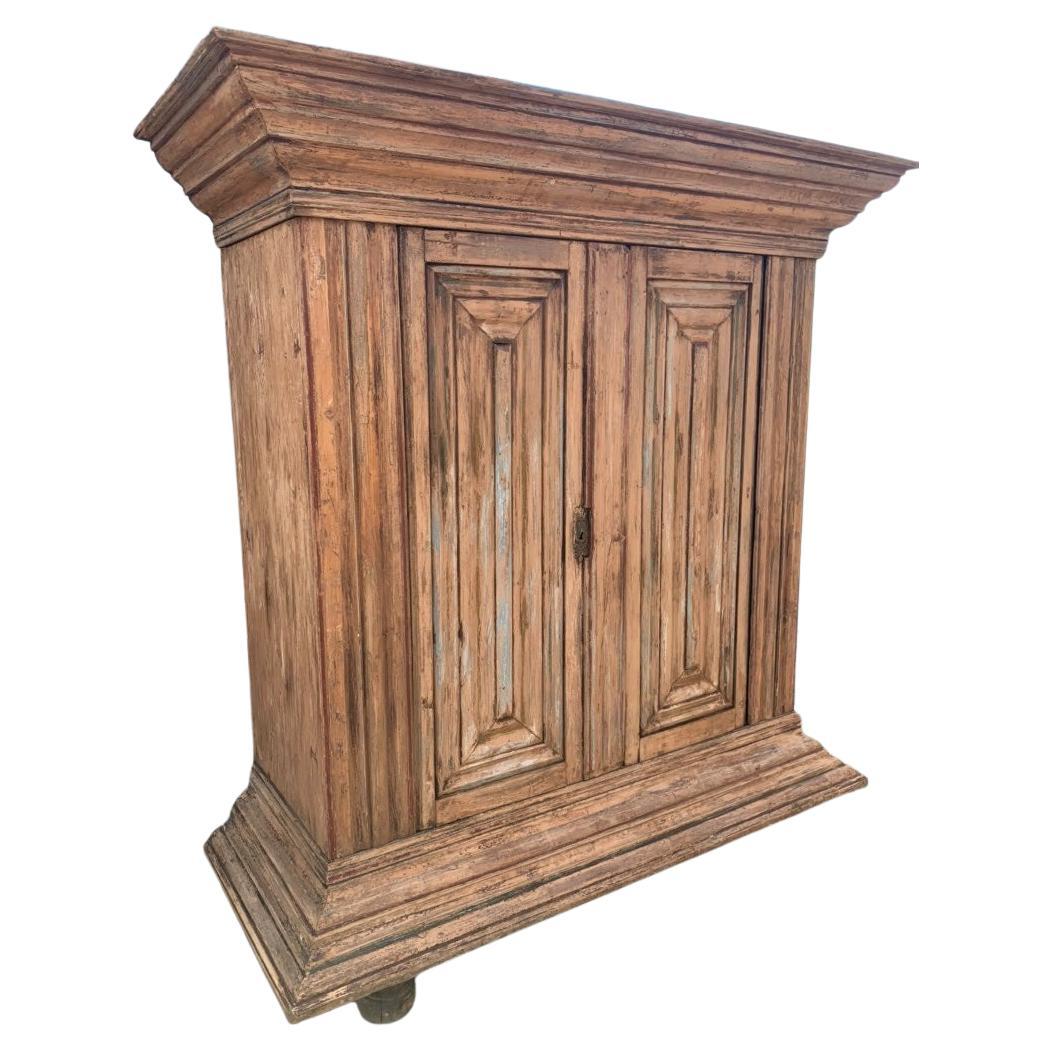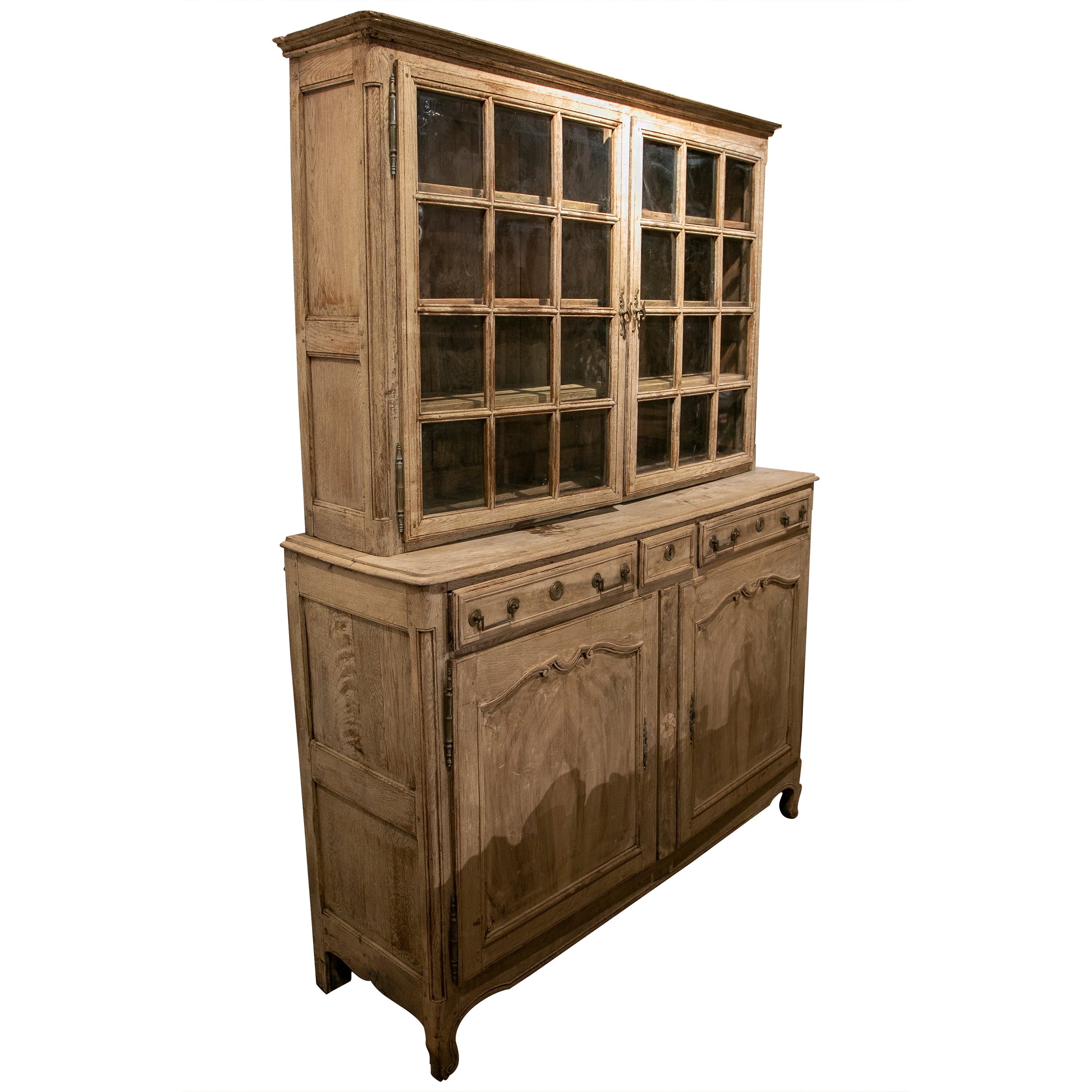Items Similar to An impressive early 18th century Dutch oak geometric kussen cabinet with integra
Want more images or videos?
Request additional images or videos from the seller
1 of 13
An impressive early 18th century Dutch oak geometric kussen cabinet with integra
About the Item
An impressive early 18th century Dutch oak geometric kussen cabinet with integral secretaire
Anonymous
Belgium or Southwestern Netherlands; probably first quarter of the 18th century
Oak, Brass, Iron
Approximate size: 64.5 (w) x 70 (h) x 26 (d) in.
Approximate weight: 160 lbs.
This imposing cabinet is a statement piece that once would have decorated the interior ‘zaal’ or reception room of a stately Dutch home. Often found in wealthy households, ‘kussen’ cabinets—so-called for their cushion-like door panels—were the vogue of late 17th and early 18th century homes.
Such cabinets were originally used to store fine linens—and in the case of this example—served also as a small writing table with hidden storage compartments. The elaborate workmanship of this cabinet features a harmonious restraint that redacts the ostentatious forms found in the earlier kussenkast cabinets of the late 17th century.
The highlight of this cabinet is its beautiful chocolate patina and its elaborate multi-profiled geometrically patterned, molded and shaped panel doors covering an upper and lower cupboard divided by a central abattant that opens to a secretaire featuring six flanking drawers and a central cabinet revealing six further smaller drawers. The drawers and doors feature their original brass keys, escutcheons and pulls, albeit one pull is lacking and another is probably a later replacement. The interior cabinet door key is lacking and is superficially secured in place by tape.
The cabinet is block footed, features handsome coffered sides and is surmounted by an out swept cornice. Overall, this fine example of Golden Age Dutch cabinet making showcases a discrete luxury fitting for both antiquarian or modern homes.
Condition commensurate age, featuring general marks, minor scuffs, nicks, scratches, fissures, wear, scattered losses and woodworm due to old water damage along the raw hewn planks along the lower back wall of the cabinet.
Ships from our storage facility in Belgium and may require ocean freight delivery if shipping to the USA. Please allow 10-to-55 days for delivery.
- Dimensions:Height: 70 in (177.8 cm)Width: 64.5 in (163.83 cm)Depth: 26 in (66.04 cm)
- Style:Baroque (Of the Period)
- Materials and Techniques:
- Place of Origin:
- Period:
- Date of Manufacture:unknown
- Condition:Replacements made: One drawer pull may have been replaced. Wear consistent with age and use. Condition commensurate age, featuring general marks, minor scuffs, nicks, scratches, fissures, wear, scattered losses and woodworm due to old water damage along the raw hewn planks along the lower back wall of the cabinet. Lacking one key.
- Seller Location:Leesburg, VA
- Reference Number:1stDibs: LU8166237443822
About the Seller
5.0
Vetted Seller
These experienced sellers undergo a comprehensive evaluation by our team of in-house experts.
Established in 2013
1stDibs seller since 2023
18 sales on 1stDibs
Typical response time: 6 hours
- ShippingRetrieving quote...Ships From: Bruxelles, Belgium
- Return PolicyThis item cannot be returned.
More From This SellerView All
- An early 18th century Florentine Ebonized Wood Aedicule CaseLocated in Leesburg, VAAn early 18th century Florentine ebonized wood aedicule case with gilt metal embellishments Ambit of Leonard van der Vinne Possibly first decade of the 18th century; Florence, Italy Approximate size: 83.5 (h) x 69 (w) x 23 (d) cm The cabinet’s centralized glass door is flanked by thick spiraling Solomonic columns surmounting a lower drawer. To the rear of the cabinet, the motif repeats in an eloquent display of perspectival treatment. The overall work is supported by a tiered base, elegantly conceived, and the cabinet is topped by a handsome pediment flanked by square plinths crested by gilt metal finials and an openwork frieze. The cabinet’s tempered and moderate form suggests an origin probably during the first decade or quarter of the 18th century. Although utilitarian in concept, the reserved and sublime expressiveness of this cabinet is managed with a quality and care respective of the influence of Florentine ebony cabinetry work conceived in the Galleria dei lavori or Grand Ducal Workshops of the 18th century Medici dynasty. In particular, its base mouldings echo a remarkable Night Clock...Category
Antique Early 18th Century Italian Baroque Vitrines
MaterialsBrass
- An antique 18th century Walnut European Santos - Saint figure on a plinthLocated in Leesburg, VAAn antique 18th century Walnut Figural Statue of Saint Peter on a plinth Anonymous Northern Europe, probably Belgium; first-half of the 18th century Walnut Approximate size: 17 (h) x 4.25 (w) x 4.25 (d) in. The present sculpture, perfectly suited for a curiosity cabinet or English-European country styled home, was likely realized for a church side chapel or choir stall niche. The serious look of the saint’s face...Category
Antique Early 18th Century Belgian Baroque Figurative Sculptures
MaterialsWalnut
- Pair of Early 18th Century Style Plaster and Wood Italian CandelabrasLocated in Leesburg, VAA pair of antique decorative plaster and wood Italian candelabras. Italy; early 18th century style, possibly made in the 19th century Approximate size: 81 cm (h) each A pair o...Category
Antique Late 19th Century Italian Baroque Candlesticks
MaterialsPlaster, Wood
- Early 17th Century Netherlandish Oak Relief of the Three Divine VirtuesLocated in Leesburg, VAAn impressive early 17th century wood relief carving of the Three Divine Virtues After Jan Pietersz Saenredam and Hendrik Goltzius First quarter of the 17th century; Northern Netherlands Approximate size: 35.5 x 50 cm (without frame); 53 x 67 cm (with frame) The present carving, of Flemish origin and from the first quarter of the 17th century, was executed during the Golden Age of Dutch art. The relief depicts the figures of Pietas, Caritas and Fides: the divine virtues of Hope, Charity and Faith. Each of the Virtues is articulated with exceptional care and the skill of a talented hand. The composition is bursting with energy, emphasized by the active putti surrounding its central protagonist and the emergence of the figures in the foreground, silhouetted against a cityscape with the upper horizon framed by clouds and rays-of-glory. The relief’s design is indebted to late 16th century Mannerist influences shown in the expressive postures of the figures and the billowing hair of Charity. Other Flemish artists approached this theme like the painters, Maarten de Vos, Maarten van Heemskerck, et al. However, our particular carving is an amalgam of three individual compositions engraved by Jan Pietersz Saenredam in 1601, and based on the designs of his mentor and long-time collaborator, Hendrik Goltizius (presumably following inspired Latin prose conceived by the Haarlem Humanist, Cornelis Schonaeus). The relief is set in an elaborate checkered, wood-inlaid frame but its scale and shape suggest it probably once formed part of an elaborate Beeldenkast or impressive Dutch oak cupboard...Category
Antique 17th Century Dutch Baroque Decorative Art
MaterialsOak
- A Rustic European 18th century French faience fountain with spigotLocated in Leesburg, VAAnonymous Mid-18th century; probably Moustiers or Nevers, France Faience and brass Approximate size: 12.25 (h) x 9 (w) x 6.25 (d) inches The present dispenser was either used as a water or wine cooler or possibly for washing hands. The original lid is lost-to-time, yet its provincial beauty remains attractive and sublime. The present example—baked with white enamel and decorated with a lovely hand-painted polychrome lattice and floral theme—is warm, elegant and rustic. The curving linear form of the flowers subtly recall the influence of Japan’s Kakiemon style present in France during the Rococo period yet is still indebted to the earlier influence of Italy’s prolific maiolica workshops. This fountain would serve as an elegant addition for display on an oak or distressed wood console table...Category
Antique 18th Century French Rustic Jars
MaterialsFaience, Porcelain
- Elegant 18th century style pewter pitcher by Arte Italica - Made in ItalyLocated in Leesburg, VAThis luxurious pitcher is inspired by models of the early 18th century. Each one-of-a-kind pitcher produced by Arte Italica is a marriage of the highest quality pewter combined with ...Category
2010s Italian Baroque Pitchers
MaterialsPewter
You May Also Like
- An Early 18th Century Swedish Period Baroque Kas Cabinet with Ebonized AccentsLocated in Atlanta, GAA Swedish 18th century period Baroque "Kas" or "kast" cabinet. This large-sized period Baroque cabinet features a nicely molded and overhung cornice, with pair of chubby-faced putti ...Category
Antique 18th Century Swedish Baroque Cabinets
MaterialsMetal
- English 18th Century Oak CabinetLocated in Baton Rouge, LAThis wonderfully carved solid oak cabinet was crafted in the 1700s with style and functionality in mind. Thumbnail molded paneling on the front and sides give it fantastic depth. The...Category
Antique 18th Century English French Provincial Wardrobes and Armoires
MaterialsHardwood, Oak
- Antique early 18th Century German Baroque Stripped Oak Two-Door Wardrobe CabinetLocated in Casteren, NLThis antique oak cabinet was crafted in the early 20th century in the German state of North Rhine-Westphalia around 1720. The cabinet was entirely built from the finest quality European summer oak. It features two doors and is richly adorned with molding in geometric patterns. The wooden molding was attached to the oanels by the use of pegs. The doors showcase a floral maple inlay. They retain their original hinges, while the lock has been replaced. Inside, on the right-hand side, there are two and a half fixed shelves, and on the left-hand side, there is a hanging section. This cabinet was made from the most exquisite wood available at the time, beautiful European summer oak, displaying a distinctive flame pattern. Due to its age, the wood has acquired a rich, dark patina. The cabinet has been recently cleaned. Like many German oak cabinets...Category
Antique Early 18th Century German Baroque Wardrobes and Armoires
MaterialsSteel
- Early 18th Century Swedish Gustavian CabinetLocated in San Angelo, TXA stunning and unique baroque early 18th century Swedish Gustavian cabinet that features two doors with shelving inside and sets on ball feet. This piece completely breaks down to he...Category
Antique Early 18th Century Swedish Gustavian Wardrobes and Armoires
MaterialsWood, Paint
- 18th Century Baroque Oak Wood Wardrobe / Cabinet from GermanyLocated in Darmstadt, DEThis big Baroque wardorbe from Germany is made 1747. This cabinet is made of solid oak with walnut fillings in the doors. All locks, fittings and the key are original. The cabinet i...Category
Antique Mid-18th Century German Baroque Wardrobes and Armoires
MaterialsOak, Walnut
- 18th Century English Oak Display Cabinet with Originals Glasses PanelsLocated in Marbella, ES18th century English oak display cabinet with originals glasses panels.Category
Antique 18th Century English Vitrines
MaterialsOak
Recently Viewed
View AllMore Ways To Browse
Belgian Oak And Iron Cabinet
Dutch Armoire 17th Century
Luxury Wardrobe Cabinet
Belgian Oak Armoire
Antique School Cupboard
Southwestern Cabinet
Beautiful Dutch Secretaire
Golden Oak Cabinets
Original General Store Cabinet
Oak Cabinet From Belgium
Abattant Cabinet
Geometrical Cabinet
Armoire With Television Cabinet
Antique Hand Painted French Armoire
British Art Deco Wardrobe
Cherry Wood 19th Century French Armoire
Chicken Wire Armoire
Amish Armoire





